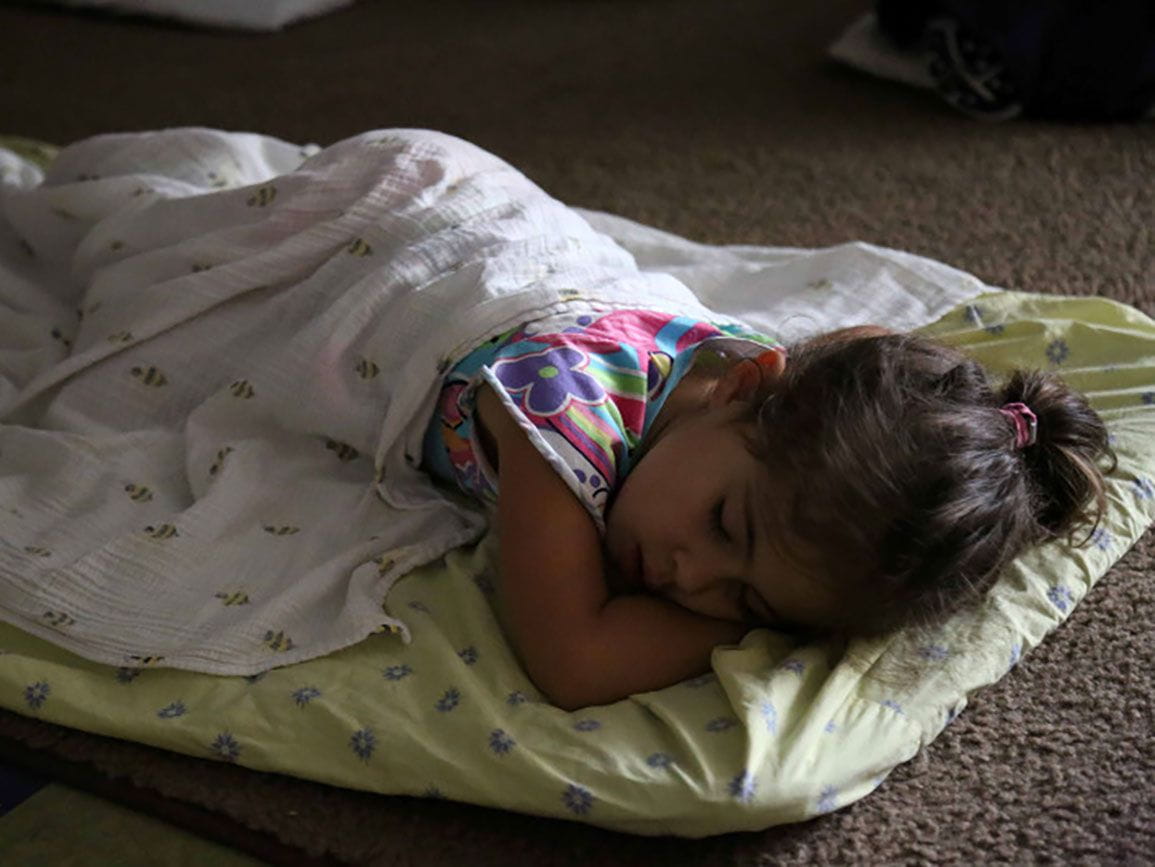Sleep is a popular topic—particularly among parents. “Is he sleeping through the night?” and “I was up all night with the baby,” are common conversation starters. In response, there is no shortage of advice from blogs, social media, and books on the topic of sleep.
Sleep routines and patterns are deeply personal and greatly impacted by one’s background, culture, family beliefs, and past experiences. There is not a “one-size-fits-all” answer for improving the quality and quantity of sleep. Rather than changing with each new fad, or the latest advice, each person and family should find solutions to fit their lifestyles.
This sleep guide offers information on a variety of topics, such as:
- Sleep recommendations by age
- General suggestions for supporting children’s sleep
- Vacation sleep strategies
- Naptime basics
Sleep Recommendations by Age: How Much Sleep Do Kids Need?
Every child and family is different, and there’s no one right answer. In general, though, infants need 12 to 17 hours of sleep each day, according to the National Sleep Foundation; toddlers and young preschoolers sleep 11 to 14 hours, while preschoolers typically need between 10 and 13 hours of sleep daily.
How to Support Children’s Sleep
Set the stage. Kids’ engines tend to run hard all day long, but a slow-down period in the afternoon or evening is essential to peaceful sleep. Take a walk after dinner, read books together, or play quietly. This might not be the best time to have an all-out wrestling match. A warm bath can be very soothing, helping your child to relax and sleep.
Turn off technology. Screens emit blue light, which can actually rev up the brain and lead to trouble falling asleep. Additionally, television programs or games with bright colors, flashing lights, or songs stimulate children. Practice healthy technology use with children, turning off all screens at least an hour before bedtime or naptime. If you can’t avoid computers, install software, such as t.lux for Windows and f.lux for Mac, which changes the light from blue-white to yellow in the evening to help children fall asleep faster, according to behavioral scientist Wendy Troxel.
Offer a snack. A high-protein snack, that is. Children often wake in the night because they’re hungry. Offering a snack rich in protein or complex carbs can give them the fuel they need to sleep through the night. Think cheese and whole-grain crackers, peanut butter on whole-wheat bread, yogurt, hummus and pitas, or a glass of milk.
Take a breath. Like toilet learning and eating, sleep is one area that parents tend to feel guilty about, even though we have limited control over it. Most children go through cycles of sleeping well and sleeping fitfully. Just like adults, children have individual differences in sleep patterns and needs. Additionally sleep can be impacted by a variety of factors, such as illness, teething, developmental milestones, or changes in the home and environment.
So, why is sleep important for children? We know that the effects of sleep deprivation can manifest themselves in the classroom, making healthy sleep essential for learning and growth. However, sleep is cumulative. Children tend to recover quickly from a few nights of lost sleep—probably more quickly than their parents! Some children give up naptimes earlier than others. In general, though, given a peaceful environment and opportunity, children will catch up on sleep when they need to.
Keep a bedtime routine. Routines are integral to encouraging positive sleep health; they do not have to be rigid, but should follow a predictable pattern. Work days may follow a slightly different pattern than weekends. When you encounter a later than usual night with your child, resist the urge to bypass routine completely. An overtired child (and adult) needs even more strategies or support to calm down. Keep some pieces of your typical schedule in place, but spend a little less time on each. Read a shorter book, wash up with some running water instead of a bath, or sing just one song.
Try to keep the same bedtime and wake time each day. While this is not always possible in our busy lives, try to resist the urge to sleep in on weekends, which sets off the sleep-wake pattern. As you find the bedtimes that work for your household, follow a reliable and predictable pattern each night.
Involve older children in planning what happens before bed. Some children relax with an evening bath, a story, or a little quiet dedicated child-parent time. Others might enjoy some guided imagery and a few restful yoga poses. Together, you and your child may enjoy a few moments of meditation or stretching before bed. As your child becomes familiar with a routine, he can gently start to guide himself into relaxation and recognize his own sleep cues. As your child grows, he will stick to some of these strategies and take initiative for developing his own bedtime routine.
Your own evening routine is also important. What do you do after putting your child to bed? What do you find relaxing? Try to incorporate your favorite calming experiences into your bedtime routine.
Supporting Children’s Sleep Routines When You’re on Vacation
You are looking forward to an upcoming vacation with great anticipation. You are hoping to finally get a little caught up on your sleep. And then it happens: your toddler is standing by your bed at 4 a.m., awake and ready for the day to start.
When you are on a getaway vacation, sudden sleep issues for children are likely related to the excitement of the trip, the change in routine, being in an unfamiliar environment, or even jet lag. Pediatrician Dr. Craig Canapari, MD, of Massachusetts General Hospital for Children, offers these tips for helping children to sleep while on vacation.
- Respect the routine. While on vacation try to maintain your children’s regular sleep schedule when possible, which might mean missing out on some sightseeing or having an early dinner to avoid long wait times. But it will pay off the next day when the family is well rested.
- Go to bed early. Vacations can be more exhausting than your typical routine. Your best chance to catch up on sleep is to turn in early. This is especially true while vacationing with other families who also have young children.
- Make the room dark. Our body’s natural tendency is to wake when it’s light and sleep when it’s dark. Closing curtains or hanging towels over the window can make a huge difference in when your child wakes up.
- Get creative with the sleeping arrangements. Try to create sleeping arrangements that are most conducive to sleeping even if a little outside the norm. For instance, place a “pack and play” or portable crib in a quiet nook away from windows or pair up older children in rooms so as not to be disturbed by early risers. While vacationing with other families, older children should be instructed to let others sleep if they wake early.
- Prepare for jet lag. Jet lag occurs when traveling across time zones. You can prepare by putting your children to bed later for a few days before traveling west or getting them up a bit earlier prior to traveling east. Once at your destination, it is best to get your child’s routine aligned with local time. If they stay up late on the first night, try to wake them as close to their usual time as possible and avoid allowing children to take longer than usual naps during the first day or two. Children tend to adapt quickly if they have natural light exposure so plenty of sunlight can help.
- Be realistic and have fun. Although vacation with little ones may not exactly be restful, the key to enjoying your family getaway is to keep expectations realistic and have fun. You may not get to as many activities, visit as many tourist destinations, or take long naps on a beach, but it can be just as fun digging holes in the sand, looking at snails, riding bikes, and enjoying family meals.
Children’s Naps
Naps are one of those aspects of parenting that tend to evoke controversy. Everyone has an opinion, and sleep-deprived parents are often left wondering what they’re doing wrong when their child doesn’t follow the “ideal” sleep schedule. Yet, sleep, like toilet training and eating preferences, is highly individualized. Some children consistently take naps until the late preschool years. Other children are less predictable—taking cat naps here and there, even from early infancy.
Naptime: Myths and Research
In 2015, researchers from the Queensland University of Technology School of Psychology and Counseling in Australia reviewed 26 studies on the sleep of children ages 5 and younger. Their findings, published in Archives of Disease in Childhood, found plenty of evidence for the importance of adequate high-quality nighttime sleep for children’s healthy growth and development, but very little evidence of the benefits of daytime naps. They also discovered a direct correlation between napping in older toddlers and preschoolers and poor nighttime sleep.
Drawing Conclusions
What does all this mean in practical terms? The study doesn’t say that naptimes are bad—just that naps might not be as necessary for older toddlers and preschoolers as we generally believe. A single, universal age when toddlers stop napping or one optimal naptime for children does not exist.
Parents can feel comfortable taking a flexible approach to naps, based on the needs of their child and the household. For example, a child who has trouble waking in the morning or frequently falls asleep on short car rides probably isn’t getting enough sleep and may still need a nap. Irritability or trouble focusing can also be a sign of inadequate sleep. On the other hand, the child who goes to bed and wakes easily at a reasonable hour and has the stamina to stay awake all day can probably give up naps. Some young children might need a nap while attending child care but forego a nap on the weekends.
Parenting Tips for Naptime
Below are some suggestions on making naps a pleasurable, comfortable experience for your child:
Be as consistent as possible. Schedule changes are bound to happen—and young children can adjust—but maintaining a predictable nap schedule helps children fall asleep more quickly and easily.
Set the stage. Children, with their busy minds and bodies, often need some help to unwind for naps. Going for a gentle walk after lunch and reading stories together can ease the transition from play to sleep. A quiet, cozy room with peaceful music or white noise can also help.
Adjust the schedule. A long afternoon nap can wreak havoc on bedtime, setting children (and parents) up for a late night and fitful sleep. Children may need to wake earlier in the morning so they go down earlier for a nap. Many families find that making small adjustments to the sleep schedule works best.
Create downtime. Children who’ve outgrown naps can still benefit from quiet time in the afternoon—30 minutes to 1 hour to play quietly or read books. When overtired, children will sometimes fall asleep during this time even if they don’t need a nap every day.
We know that young children need plenty of sleep for brain development and physical growth, yet exactly how much (and when) is somewhat fluid. For many parents, a flexible approach works best.
More on Naptime
- Find out which questions to ask about curriculum and naptime schedules when your child is moving up from infants to toddlers.
- Hear from a pediatrician specializing in the care of children with sleep and breathing problems to find out how to get your children to go to sleep and stay asleep.





